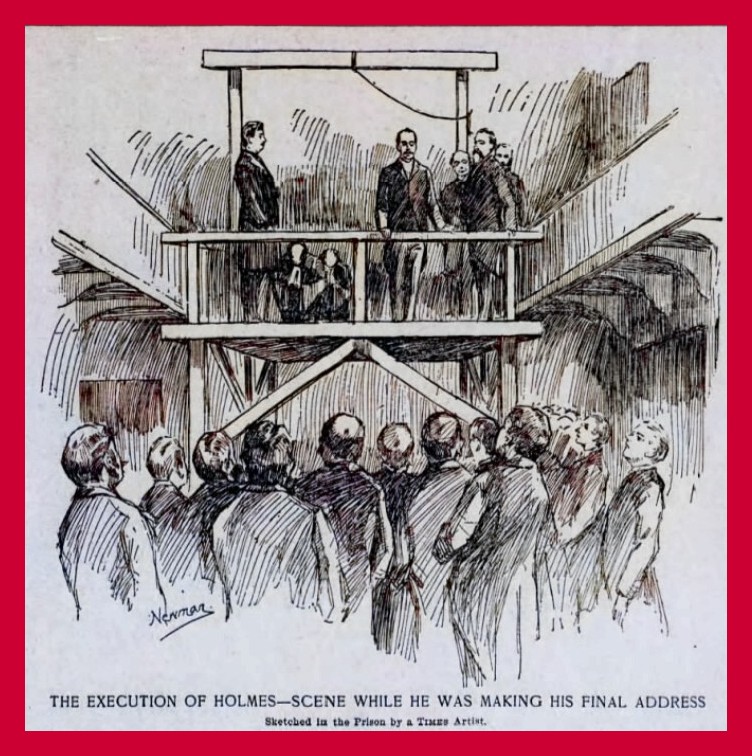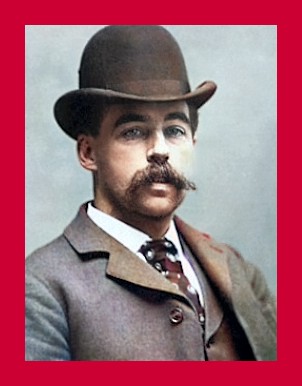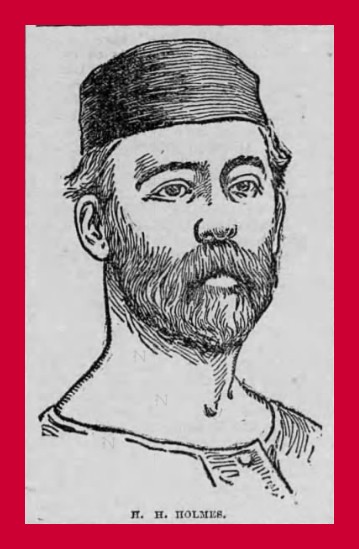At Moyamensing Prison, Philadelphia, “The Execution of Holmes – Scene While He Was Making His Final Address,” sketched by an artist for the Philadelphia Times, and published in the Times, May 8, 1896.
A portrait of Herman Webster Mudgett (1860-1896) alias H. H. Holmes, who was hanged in May 1896, for the murder of members of the Pietzel family. At the gallows, he denied committing the murders, but confessed to being responsible for the deaths of two women on whom he performed abortions. The women were never identified.
The story of H. H. Holmes was followed closely by newspaper readers in the Lykens Valley area. The Pine Grove Press Herald, the Elizabethville Echo, and the Lykens Standard covered it, as did the city papers in Pottsville, Sunbury and Harrisburg.
The Pine Grove paper even included an artist’s sketch of Holmes, May 15, 1896, shown above.
Some of the local news coverage is presented in this blog post. It is followed by a few of the most interesting stories reported in the city papers which provided very detailed coverage.
_________________________________________
From the Lykens Register, April 24, 1896:
HOLMES PROFESSES RELIGION
The Murderer Admitted to the Roman Catholic Church
PHILADELPHIA, April 22 [1896] — H. H. Holmes, the arch murderer, has been admitted to the Roman Catholic Church through the rites of baptism. Rev. Father P. J. Dailey, accompanied by Rev. Fathers D. E. Cantillon, Higgins, and McCale, visited the county prison and performed the ceremony.
The condemned man went through the service solemnly, his eyes seldom wandering from Father Dailey’s face. The baptism was made conditional because Holmes previously immersed in the Protestant faith.
Father Dailey states that Holmes was to all appearances sincere in his profession of repentance, and that he is apparently resigned to his execution, which will take place on May 7.
_________________________________________
From the Lykens Register, May 1, 1896:
AFTER HOLMES MONEY
Mrs. Pitezel Wants Some of the Money Taken From Her
PHILADELPHIA, April 27, [1896] – Mrs. Carrie Alice Pitezel, widow of Benjamin Pitezel, who was murdered by H. H. Holmes, arrived in Philadelphia last Thursday. She wants to obtain part of the money out of which she was swindled by Holmes.
An attempt will be made to find some of the money paid Holmes for his alleged confession. It is said that he received $7,500 for this.
_________________________________________
From the Elizabethville Echo, May 14, 1896:
HOLMES HANGED
H. H. Holmes was hanged in Moyamensing Prison Thursday morning. The drop fell at 10:12 1/2 o’clock. It was not until a half hour later that he was pronounced dead. His neck was broken by fall. The marvelous nerve of the man did not desert him at the end, for on the scaffold he was probably the coolest man in the solemn assemblage. In a few well chosen words he proclaimed his innocence of any murder, including that for which he was convicted and hanged. He declared that the only wrong-doing in the taking of human life for which he could be held consisted in the death of two women who died as a result of criminal operation at his hands. He did not name these victims.
_________________________________________
From the Pine Grove Press Herald, May 15, 1896 (including the artist’s portrait shown above):
MURDERER HOLMES HUNG
THE NORTORIOUS CRIMINAL EXECUTED IN PHILADELPHIA
HE MET HIS FATE STOICALLY
One of the Most remarkable Criminals of the Century Pays the Penalty for His Many Murders in Moyamensing Prison – He Was Courageous to the Last – A Sketch of His Career of Crime
PHILADELPHIA, May 9 [1896] – Herman Mudgett, alias H. H. Holmes, the insurance swindler and murderer was hanged in Moyamensing Prison Thursday at 10:12 a.m. He was officially pronounced dead thirty minutes after the trap was sprung. His neck was broken.
Holmes spent the greater part of his last night writing letters. At midnight he went to bed and slept soundly until six o’clock a. m. It took two calls to awaken him. Promptly arising, he received a visit from his spiritual advisors. They administered the last sacrament and left him until nearly nine o’clock. At 10:02 o’clock the Sheriff called together the official jury, and after each man had answered to his name and subscribed to the certificate, the march to the gallows was begun.
Holmes nerve did not desert him at the end, and on the scaffold he showed remarkable coolness. In a few words he proclaimed his innocence of any murder, including that for which he was convicted and hanged. He said:
“Gentlemen, I have very few words to say. in fact, I would make no remarks at this time except that by my not speaking I would appear to acquiesce in my execution. In only wish to say that the extent of my wrongdoing in taking human life consisted in the death of two women, they having died at my hands as a result of a criminal operation [abortion]. I wish to state here, so there can be no chance of misunderstanding, that I am not guilty of taking the lives of any of the Pietzel family – the three children and Benjamin, the father – of whose deaths I was convicted, and for which I am to-day to be hanged. That is all I have to say.”
_______________________________________________________
Holmes’s criminal career was summarized in a Pine Grove Press Herald article of May 15, 1896:
The murder of Benjamin F. Pietzel, for which Holmes was hanged, was committed in September 1891. The crime was the culmination of a conspiracy to defraud the Fidelity Mutual Life Association of Philadelphia of $10,000, the amount of a policy on Pietzel’s life. The swindle was successfully accomplished. Pietzel and Holmes became acquainted in 1890 at Chicago. Pietzel, who had a wife a six children, was poor, and willing to participate in dishonest transactions if sufficiently paid. The two men began by forging papers of various kinds. Pietzel was arrested for forgery, but escaped, forfeiting $1800 worthless bail, which had bee given by Holmes. They then operated in Fort Worth, Texas, and in St. Louis, from both of which places they were forced to flee. After leaving St. louis, the insurance swindle was planned. A $5000 policy was first taken out in the Washington Life Insurance Company, but this was allowed to lapse, and the Fidelity policy for $10,000 was substituted, the application being made at the Chicago agency. The plan was to get a body and palm it off as that of Pietzel.
In August, 1894, the two men went to Philadelphia, and rented an old building at 1316 Callowhill Street, where Pietzel was to start in the patent business under the name of B. F. Perry. The two men were often seen together. On Saturday night, September 1894, Pietzel was seen for the last time alive. He had been drinking a good deal during the day. On the following Monday his dead body, badly burned, was found on a floor in a back room in the house. A broken bottle, which had contained benzine lay near the body, and there was a pipe partly filled with tobacco. The police believed that an explosion had accidentally occurred, and no theory of murder was advanced by them. The autopsy, however, showed that death had resulted from chloroform.
About three weeks later, Jeptha D. Howe, a St. Louis attorney, went to Philadelphia, asserted that the body was that of Pietzel, in whose favor the insurance policy was drawn, took steps to collect the money. Holmes, who had introduced Pietzel to the insurance agent, was sent by the company to Philadelphia to identify the body, which he did. The policy was accordingly paid.
Some time later, Marvin C. Hedpeth, in jail at St. Louis, said that Holmes, while in an adjoining cell, had told him of a plot to swindle an insurance company, and had mentioned Pietzel’s name. This led to an investigation and the subsequent arrest of Holmes in Boston, where he was living under the name of Howard. He was tried in Philadelphia and convicted early in November, 1895.
This is the story of the murder of Pietzel, for which Holmes was hanged, but it is practically certain that he was also guilty of killing at least eight other persons. Alice Pietzel and Nellie Pietzel, whose bodies were found in Toronto, he undoubtedly killed while working to secure the insurance money from their mother. His other victims were: Howard Pietzel, killed in Indianapolis; Julia L. Conner, his bookkeeper, and Pearl Conner, her daughter; Emeline G. Cigrande, of Anderson, Indiana; Minnie R. Williams, of Fort Worth, Texas and Anna Williams, her sister.
Besides these, which definitely and almost conclusively traced to him, there are at least a dozen other cases which have been laid at his door.
_____________________________________________________
From the Pottsville Republican, May 7, 1896:
HIS DOOM SEALED AT LAST
HOLMES PAYS THE PENALTY OF HIS HEINOUS CRIMES
SWUNG OFF AT 10:12 TODAY
A Blood Thirsty Demon — Happily Places Beyond Doing Further Murder on Earth — A History of His Many Terrible Crimes — Where He was Born
[Excerpt #1]
The persons holding tickets of admission to the jail began to assemble as early as 8:30 o’clock, and at 9 o’clock they passed within the iron gates….
[When the] gates were opened… the four score and more having tickets pressed into the inner corner. Sheriff Clements had preceded the crowd and was awaiting the arrival of those comprising his jury that they might be sworn….
Many prominent men were in attendance, several from other cities, notably among them were Dr. McDonald, the famous criminologist; Sheriff S. R. Mason, of Baltimore; and many others….
[Excerpt #2]
On The Trap
On the right was Father Daily, to the left Father McFake, and bringing up the rear were Lawyer Rotan and Superintendent Richardson. The little party stood for a moment looking down, and then, in response to a sign from one of those beside him, Holmes stepped forward and spoke. Pallid, naturally, after the incarceration, there was no other evidence of any fear or disquiet. He spoke slowly and “with measured attention to every word a trifle low at first, but louder as he proceeded until every word was distinctly audible….
As he ceased speaking he stepped back and, kneeling between Fathers Daily and McFake, joined them in silent prayer for a brief minute or two. Again standing, he shook the hand of all those around him and then signified his readiness for the end. He was the coolest of the entire party….
“Take your time, don’t bungle it,” he remarked, as the official exhibited some little haste, the evident outcome of nervousness….
“The cap was adjusted, a low toned query, “Are you ready?” and an equally low response, “Yes, good bye,” and the trap was sprung.
The neck was not broken and there were a few convulsive twitches of the limbs for about ten minutes…. The trap was sprung at 10:12 and fifteen minutes later Holmes was pronounced dead, though the body was not cut down until 10:45. When it was laid out on the stretcher occurred the only incident preceding the revolting in connection with the affair, naturally gruesome. The know had become jammed and the best efforts of the doctors failed to loosen it as they attempted to remove the noose from about the neck.
The head was twisted from side to side in the unavailing attempt and finally it was decided to cut the rope. Superintendent Parkins objected, however, and the know was undone after several minutes of trying work…. The body was taken… [to] a vault in Holy Cross Cemetery. There were no services.
[Excerpt #3]
The two women referred to by Holmes in his confession from the scaffold were Julia Conner, of Chicago, who with her daughter were believed to have been murdered by him, and Emily Cigrand, of Anderson, Indiana. [Refers to Holmes’s claim of responsibility for their deaths because of abortions he performed on them].
[Excerpt #4]
The Funny Incident of All
Three minutes after the drop fell a letter carrier pulled the bell at the prison gate, and handed to the keeper a newspaper addressed to the “H. H. Holmes,” Moyamensing Prison, Philadelphia….
The keeper read the address and handed back the package with the remark: “No such man lives here.”
“How is that?” inquired the letter carrier.
“Well, he’s dead. He has just been hanged.”
The package, a copy of a New York newspaper, was returned to the mail bag….
[Excerpt #5]
Coroner’s Physician Stott appeared to be disappointed as he emerged from the jail. He had hoped, he said, that the authorities would make a post mortem examination of the body, and the carrying out of Holmes request that nothing of the kind be done, was evidently not relished by him. Dr. Scott said the murderer’s neck had not been broken, but that there had been a rupture of the muscles of the neck, which produced almost complete paralysis.
____________________________________________
From the Harrisburg Daily Independent, May 6, 1896:
HOLMES WANTS TO TALK
He Finds Consolation in Reading the Bible and Newspapers
By United Press
Philadelphia, Pennsylvania, May 6 [1896] — H. H. Holmes, who will be hanged in the county prison tomorrow for the murder of Benjamin F. Pietzel, his fellow conspirator in insurance frauds, was wakeful last night. With the exception of Short naps during the day, sleep has evidently forsaken the condemned man, and his next to the last night on earth was largely spent in talking with his death watch and in reading religious works. His choice of reading is varied to his changing moods, and although he seems to find the greatest consolation in the Bible, he frequently casts that book aside in a petulant manner and picks up a newspaper in which he has marked articles bearing upon his case. After Holmes had eaten his breakfast to-day he was visited by rev. Father Daily, his spiritual advisor, who was in the cell for over an hour preparing him for the end tomorrow. Holmes, according to Father Daily, is fully prepared for his fate and is sincere in his repentance for the numerous crimes he has committed. If Holmes can secure permission, it is said he will make a statement from the gallows, which will be in the form of his repentance. It is hardly likely that Sheriff Clement will permit an extended address on the scaffold, for he is inclined to the belief that the condemned man will talk until he collapses unless a check shall be put upon him. The sheriff prefers to have Holmes make his statement in the cell before the warrant of execution is read to him, and arrangements may be made for this, or for the leaving of a written statement to be given to the public after the execution.
____________________________________________________
Headlines from the Philadelphia Times, May 8, 1896:
HOLMES DIES DENYING GUILT
Before His Hanging He Asserts That He Did Not Murder Any of the Pietzel Family.
SPOKE CALMLY FROM THE SCAFFOLD
Leaves Minute Directions, Through Which His Lawyers Believe They Can Prove Him Innocent.
HIS BODY BURIED IN CEMENT
The Hanging of H. H. Holmes in Moyamensing Prison Yesterday Morning Was Attended With Few Sensational Features, But the Condemned Man Made a Cool, Straightforward Statement From the Gallows Denying That He Had Ever Committed Murder — The Drop Broke His Neck, But It Was Fifteen Minutes Before His Heart Ceased to Beat — He Was in Good Spirits All Morning and Conversed Freely With His Friends — Leaves No Money, But a Mountain of Manuscript — According to His Own Instructions, His Body is Embedded in a Ton of Cement In a Vault in Holy Cross Cemetery — A Truthful Story of His Remarkable Career.
___________________________________________
For further reading, see: Kathryn Canavan, “H. H. Holmes Meets the Hangman Here,” Chapter 9, True Crime Philadelphia (Rowman & Littlefield, 2021).
Articles and drawing of execution scene from Newspapers.com. Colorized portrait of Holmes from Wikipedia.


